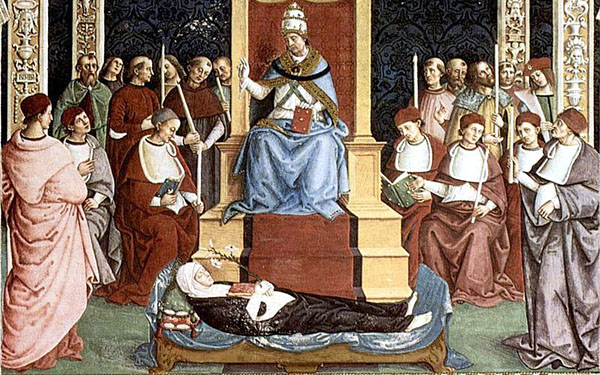Canonization is the act by which the Catholic Church declares that a person who has died is now added to the list of saints in the glory of heaven. The process takes its name from the Greek word for list (canon), and includes a comprehensive investigation of the faith, heroic virtues, and approval of any miracles worked through the person’s intercession. Once canonized the saint may be publically invoked for intercession and included in the prayers of the Church (including the Litany of Saints).
Originally a person was recognized as a saint by the local bishop and community, without a formal process or papal declaration. During the first centuries of the Church, most saints given public honor were martyrs. The members of the local Christian community who knew the martyr, and had witnessed their heroic death, gave testimony to the local bishop. Based upon his inquiry among the faithful, the bishop then decided to give permission for public prayers to the saint and veneration of their grave (and authenticated relics). The local bishop would then share the declaration of the martyr’s passion and inclusion in public prayer with other bishops in neighboring cities. Here we see the local Church promoting devotion to a new saint. These first canonizations were done a local bishop, based upon the “cult” or devotion to the saint by the local church that personally knew the martyr.
However, by the fourth century, the Church also formally honored saints known as “confessors” - Christians who had confessed their faith in Christ by word and deed rather than the shedding of their blood. Confessors were often associated with martyrs, for many confessors suffered a “white martyrdom”, quietly and heroically enduring persecution or difficulties. Local bishops began assembling testimony about hermits, catechists, missionaries, consecrated virgins, and clergy who had lived extraordinary lives of holiness. After inquiry, the local bishop named these “confessors” to the list (canon) of saints to be mentioned in public veneration of the church, and whose relics could be venerated by the faithful. Soon the “cult” (devotion) to a particular saint in a particular community, would spread through other local communities, and some later reach the Pope and the Church in Rome.

Pope Pius II canonizes Saint Catherine of Sienna. detail of paining by Pintoricchio
*********
As local bishops have local jurisdiction, the Pope alone has jurisdiction over the universal Church. When the Pope declared the martyr or confessor to be worthy of universal veneration, that saint could be honored throughout the universal church. In order to make the example and intercession of the saints accessible to the universal Church, and to avoid any abuses of the process, Pope Alexander III in 1170 reserved the authoritative decision of canonization to himself. Later popes confirmed this authority, for both canonization and beatification, leaving the local church or religious community to begin the process and declare the person a “Servant of God”. In 1588 the Sacred Congregation for Rites was formed by Pope Sixtus V to oversee the process, and in 1969, Pope Paul VI formed a new office to exclusively care for the work of canonization of saints (Congregation for the Cause for Saints).
Inside the reliquary, the saint’s name is normally identified with the title of “Venerable”, “Blessed”, or “Saint”, designating where the person was in the process when that relic was issued. During the twentieth century, many postulators also began noting the year that the relic was issued on the back of the reliquary to help document its authenticity (ie, the year of the beatification or canonization).




 Change language to English
Change language to English